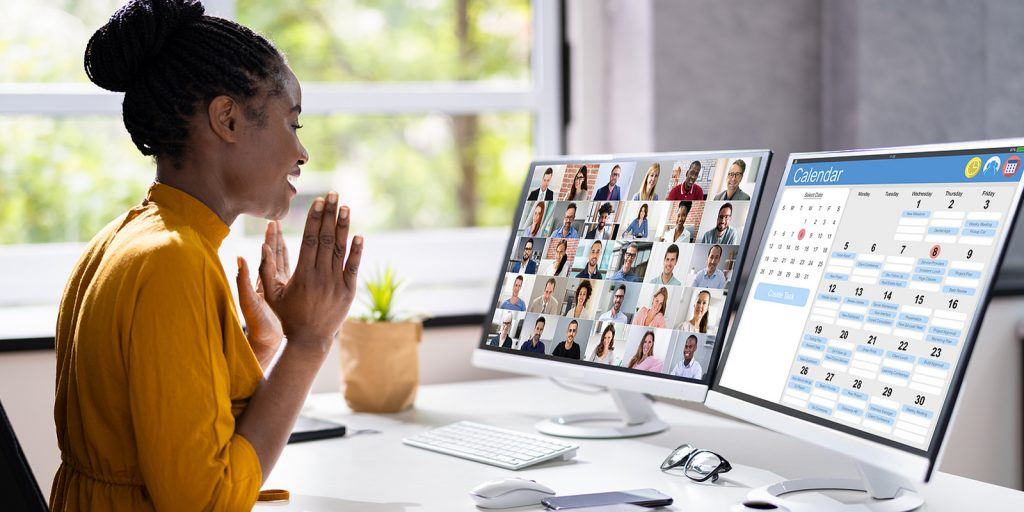Trying to find the perfect balance between work and personal life has always been a challenge. With the increasing popularity of remote work, achieving work-life balance has become even more crucial. In this article, we will dive deep into the concept of work-life balance in the context of remote work and explore various strategies to succeed and achieve work life balance in this flexible work environment.
Remote Workers’ Dedicated Workspace

In the evolving landscape of remote work and hybrid work models, the significance of a dedicated workspace cannot be overstated. As remote workers strive to achieve a healthy work-life balance, the design and functionality of their home office play a pivotal role in facilitating productivity, well-being, and overall satisfaction.
This section elucidates the essential elements of creating a conducive home office environment tailored to the unique needs of remote and hybrid office workers.
Creating a Productive and Comfortable Home Office Environment
The foundation of a productive work-from-home experience lies in crafting a comfortable and ergonomic home office environment. Begin by selecting a quiet and well-lit space that fosters concentration and minimizes distractions.
Consider the principles of environmental research that emphasize the importance of natural light, proper ventilation, and ergonomic design in enhancing productivity and well-being.
Invest in a high-quality home office chair that promotes optimal posture and supports long working hours. Personalize your workspace with inspiring decor, functional storage solutions, and essential office equipment that aligns with your work requirements. By meticulously curating your home office environment, you lay the groundwork for a seamless transition between professional tasks and personal pursuits.
Selecting the Right Furniture and Equipment
The selection of furniture and equipment profoundly influences the efficiency and comfort of your home office. Prioritize ergonomically designed furniture that aligns with your body’s natural contours and minimizes the risk of musculoskeletal disorders.
Explore innovative office equipment, such as standing desks, adjustable monitors, and noise-cancelling headphones, that cater to your specific work preferences and requirements.
Integrate technology solutions that facilitate seamless communication and collaboration with colleagues, clients, or stakeholders. By adopting a holistic approach to selecting furniture and equipment, you create a synergistic workspace that enhances productivity, creativity, and overall well-being.
Setting Boundaries and Limiting Distractions
The delineation of work-life boundaries emerges as a critical factor in achieving a healthy work-life balance. Establish clear guidelines for work hours, breaks, and personal time to cultivate a structured routine that aligns with your professional and personal aspirations.
Communicate your boundaries effectively with family members, housemates, or other occupants to minimize interruptions and foster a focused work environment.
Implement strategies to limit distractions, such as creating a designated workspace, utilizing productivity tools, and adopting time-management techniques.
Embrace the core psychological truth that underscores the importance of physical and mental breaks in sustaining optimal performance and well-being throughout the workday.
Designating Specific Work Hours and Personal Time
The designation of specific work hours and personal time epitomizes the essence of achieving a harmonious work-life balance.
Define your work schedule in alignment with your professional obligations, personal commitments, and individual preferences. Establish a routine that encompasses dedicated work hours, leisure activities, and restorative practices to nurture your physical, emotional, and mental health.
Incorporate regular breaks, such as lunch breaks, physical activities, or mental rejuvenation sessions, to recharge and recalibrate amidst the demands of remote work.
Emphasize the importance of work-life separation by creating distinct boundaries that facilitate a seamless transition between professional tasks and personal pursuits.
Maintaining Healthy Habits: Healthy Work Life Balance

In an era characterized by remote work and hybrid work models, the pursuit of a healthy work-life balance transcends conventional boundaries.
As remote and hybrid workers navigate the intricate tapestry of professional commitments and personal well-being, adopting a comprehensive approach to maintaining healthy habits becomes paramount.
This section elucidates the multifaceted strategies to foster physical vitality, mental resilience, and overall well-being in the context of contemporary work environments.
Incorporating Physical Activity into Your Daily Routine
The sedentary nature of remote work necessitates intentional efforts to incorporate physical activity into daily routines. Combat the perils of prolonged sitting by integrating short bursts of movement throughout the day. Consider investing in a home office chair that promotes ergonomic support and facilitates dynamic postures.
Leverage technology to your advantage by setting reminders for regular physical breaks. Engage in rejuvenating activities such as stretching, walking, or yoga to invigorate both body and mind.
The International Journal of Environmental Research underscores the pivotal role of physical activity in mitigating the adverse effects of prolonged sitting, emphasizing the importance of a balanced approach to work and well-being.
Importance of Regular Exercise and Movement
The core psychological truth that underpins a healthy work-life balance is the symbiotic relationship between mental and physical well-being. Prioritize regular exercise as a cornerstone of your daily routine, recognizing its profound impact on cognitive function, emotional health, and overall vitality.
Allocate dedicated time for structured workouts or recreational activities that resonate with your preferences and lifestyle. Whether it’s a brisk morning jog, a sunset yoga session, or a rejuvenating swim, find activities that nourish your soul and invigorate your body.
The nexus between physical activity and mental resilience is well-documented, affirming the integral role of regular exercise in achieving a harmonious work-life balance.
Practicing Mindfulness and Stress Reduction Techniques
In the pursuit of work-life balance, cultivating mindfulness and stress reduction techniques emerges as a transformative practice. Embrace mindfulness as a restorative mental activity that fosters presence, awareness, and inner tranquility amidst the hustle and bustle of professional commitments.
Explore diverse techniques such as meditation, deep breathing exercises, or progressive muscle relaxation to alleviate stress and enhance emotional equilibrium.
Create a serene sanctuary within your home environment where you can retreat and recharge, facilitating a seamless transition between work tasks and restorative practices.
Enhancing Mental Well-being and Resilience
The confluence of remote work, hybrid work models, and traditional office settings underscores the imperative of prioritizing mental well-being and resilience.
Recognize the unique challenges and opportunities associated with mental health website and with your work environment, and proactively develop strategies to nurture your psychological health.
Engage in open dialogues with colleagues, supervisors, or mental health professionals to address existing mental health issues and foster a supportive work culture. Develop policies and initiatives that facilitate work-life boundaries, encourage regular breaks, and promote a holistic approach to well-being.
The Future of Work-Life Balance in Remote Work

As remote work continues to evolve, the concept of work-life balance will also adapt to meet the changing needs of employees and organizations. Here are some predicted trends:
Predicted Trends in Remote Work
Flexible work arrangements, such as hybrid models that combine remote and in-office work, may become more prevalent.
Companies will likely invest in building a remote work culture that emphasizes work-life balance and employee well-being.
Additionally, advancements in technology, such as virtual reality, could further facilitate work life balance enhance remote collaboration and bring new possibilities for work-life integration.
Maintaining Work-Life Balance in a Post-Pandemic World
As the world emerges from the pandemic, remote work will continue to be a viable option for many. However, it is crucial to ensure that work-life balance remains a priority in person workers even as work environments evolve. Organizations and individuals must recognize the importance of work-life balance and actively foster an environment that supports it.
Nurturing Social Connections: The Pillars of Relationship Building in a Digital Era

In the intricate tapestry of remote work and hybrid work models, the essence of nurturing social connections transcends geographical barriers and traditional office settings.
As remote workers navigate the labyrinth of achieving a healthy work-life balance, the cultivation of meaningful relationships with colleagues, friends, and family emerges as a cornerstone of well-being and professional fulfillment.
This section delves into the multifaceted strategies for fostering social connections and enriching interpersonal relationships in the context of remote and hybrid work environments.
Building and Maintaining Relationships with Colleagues
The realm of remote work underscores the imperative of intentional efforts to build and maintain relationships with colleagues.
Leverage digital communication platforms, such as video conferencing, instant messaging, and collaborative tools, to facilitate seamless interactions and cultivate a sense of camaraderie within virtual teams.
Initiate informal conversations, virtual coffee breaks, or team-building activities to bridge the physical distance traditional office setting and foster a collaborative work culture. Embrace the core psychological truth that emphasizes the intrinsic human need for social connection and mutual support in achieving a harmonious work-life balance.
Engaging in Virtual Team Activities and Collaboration
The advent of remote and hybrid work models necessitates innovative approaches to virtual team activities and collaboration.
Organize virtual workshops, brainstorming sessions, or collaborative projects that encourage active participation, creativity, and knowledge sharing among remote employees and hybrid workers.
Explore interactive platforms and digital tools that facilitate real-time collaboration, co-creation, and collective problem-solving fully remote employees. By embracing a collaborative mindset and leveraging technology, you can foster a dynamic and inclusive work environment that resonates with the diverse needs and aspirations of remote and hybrid teams.
Establishing a Supportive Network of Friends and Family
Amidst the demands of remote work and professional commitments, the establishment of a supportive network of friends and family remains paramount. Prioritize quality time with loved ones, engage in shared activities, and nurture meaningful conversations that enrich your emotional health and overall well-being.
Leverage digital platforms and social media to stay connected with friends and family members, regardless of geographical constraints or time zones. By cultivating a supportive network of relationships outside of work, you create a resilient foundation that enhances your mental health, emotional resilience, and work-life balance.
Cultivating Meaningful Connections Outside of Work
The pursuit of a healthy work-life balance extends beyond professional relationships to encompass meaningful connections outside of work. Engage in community involvement, pursue shared hobbies, or participate in social events that align with your interests and values.
Embrace opportunities for personal growth, cultural enrichment, and lifelong learning that transcend the confines of your professional identity. By cultivating a diverse portfolio of relationships and experiences, you foster a sense of fulfillment, purpose, and holistic well-being that resonates with your unique aspirations and lifestyle choices.
Nurturing social connections in the context of remote and hybrid work environments necessitates a multifaceted approach that encompasses professional relationships, virtual collaboration, familial bonds, and meaningful connections outside of work.
By prioritizing these pillars of relationship building, remote workers can cultivate a rich tapestry of social connections that enhance their well-being, professional fulfillment, and overall quality of life in an increasingly interconnected and digital world.
In conclusion, work-life balance is an essential aspect of remote work success. By understanding the concept great work life balance well, adopting effective strategies, and utilizing the right tools and resources, you can navigate the challenges of remote work while maintaining a healthy and satisfying balance between your professional and personal life.

